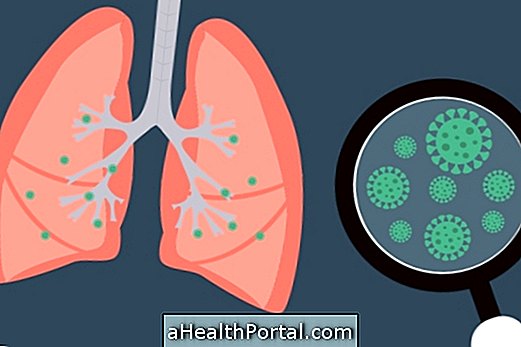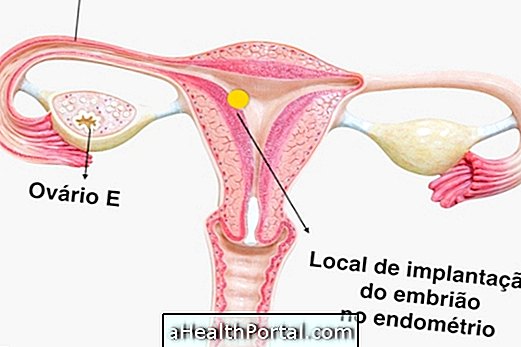Bronchitis is the inflammation of the main airways in the lungs, the bronchi, which are responsible for transporting oxygen to and from the lungs, causing them to become irritated and inflamed and causing symptoms such as dry or phlegm cough, wheezing or lack of air. of air.
This disease can be caused by a common cold, flu or other respiratory infection, characterizing acute bronchitis, which is a temporary inflammation of the bronchi and usually lasts from 1 to 3 weeks and can affect people of all ages, but it occurs mainly in children under 5 years old.
However, when the irritation or inflammation of the lining of the bronchi is constant, the person has a daily cough that lasts for more than 3 months or has many repeated episodes of bronchitis in the year, this disease is called chronic bronchitis.
Bronchitis should be treated with medications indicated by the pulmonologist, such as bronchodilators, antibiotics, corticosteroids or antitussives, depending on the type of bronchitis the person has.

Main symptoms
Some of the symptoms that may indicate that the person has bronchitis are:
- Dry or phlegm cough;
- Clear, white, yellowish-gray or green phlegm, and there may also be blood in some cases;
- Shortness of breath or difficulty in breathing;
- Noises when breathing;
- Chest discomfort;
- Purplish or bluish lips and fingertips;
- Swelling in the legs;
- Fever or chills;
- Tiredness;
- Lack of appetite.
In the case of acute bronchitis, the person may also show symptoms similar to the common cold or sinusitis such as sore throat, head or body pain and a runny or stuffy nose, which usually improve within 1 week.
However, if the cough continues for more than 3 weeks, the person has a fever for more than 3 days in a row or has difficulty breathing, medical help should be sought immediately, as bronchitis can develop into pneumonia, and should always be treated by the pulmonologist or general practitioner. Learn how to identify the symptoms of pneumonia.
The diagnosis of bronchitis is made by the pulmonologist based on the assessment of symptoms and auscultation of the lungs and tests, such as chest x-rays to check for the presence of pneumonia, sputum examination, spirometry and pulmonary function test, which allow to identify the cause and, thus, indicate the best form of treatment.
Possible causes
The most common cause of bronchitis, especially acute bronchitis, is virus infections, such as colds and flu, or infections by bacteria, less common, which can cause irritation and inflammation in the bronchi that increase in volume and produce more phlegm, which decreases airflow in the lungs, making breathing difficult.
Smoking is another common cause of bronchitis, as exposure to cigarette smoke causes constant irritation in the bronchi, leading to the development of chronic bronchitis.
In addition, exposure to dust, pollen or air pollution, can trigger allergic bronchitis, which is not always curable, but the use of vaccines can be useful to control the allergic reaction and prevent episodes of bronchitis.

How the treatment is done
Most cases of acute bronchitis improve without treatment within a few weeks, but in some cases the pulmonologist may recommend the use of medications such as:
- Painkillers, such as dipyrone or paracetamol, to relieve fever;
- Anti-inflammatories, like ibuprofen, for headaches or body aches and reduce bronchial inflammation. It is important to note that ibuprofen or other types of non-steroidal anti-inflammatory drugs should not be taken by people who have asthma, as it can make symptoms worse.
- Expectorants, such as guaifenesin or ambroxol, to increase phlegm elimination;
- Mucolytics, such as acetylcysteine or bromhexine, to make the phlegm more liquid, facilitating its elimination;
- Antitussives, such as dextromethorphan or clobutinol, to reduce dry cough;
- Antibiotics to fight bacterial infection.
In addition, in the case of chronic bronchitis, the doctor may recommend the use of bronchodilators such as salbutamol or ipratropium bromide, to open the bronchi and facilitate breathing, and corticosteroids that can be used orally or inhaled to control inflammation of the bronchi. Learn more about treating bronchitis.
In some cases, especially of chronic bronchitis, physical therapy sessions help to increase breathing capacity and eliminate secretions, through manual techniques, use of breathing apparatus and breathing exercises.
Watch the video with Dr. Mirca Ocanhas with physiotherapy exercises for bronchitis:

Care during treatment
Some important measures must be taken during the treatment of bronchitis, such as taking the medication at the correct times as instructed by the doctor, not smoking to reduce the irritation of the bronchi, resting and drinking plenty of fluids, such as water or teas, to fluidize the phlegm, facilitating its elimination.
In addition, you can use a humidifier or breathe water vapor during the bath to help eliminate phlegm.
The use of medicinal plants with antiseptic and expectorant properties such as copaiba oil can also help in the treatment of bronchitis. See other home and natural remedies that help in the treatment.
Was this information helpful?
Yes No
Your opinion is important! Write here how we can improve our text:
Any questions? Click here to be answered.
Email in which you want to receive a reply:
Check the confirmation email we sent you.
Your name:
Reason for visit:
--- Choose your reason --- DiseaseLive betterHelp another personGain knowledge
Are you a health professional?
NoMedicalPharmaceuticalsNurseNutritionistBiomedicalPhysiotherapistBeauticianOther
Bibliography
- KINKADE, Scott; LONG, Natalie A. Acute Bronchitis. Am Fam Physician. 94. 7; 560-565, 2016
- ALBERT, Ross H. Diagnosis and treatment of acute bronchitis. Am Fam Physician. 82. 11; 1345-50, 2010
- KIM, Victor; CRINER, Gerard J. Chronic bronchitis and chronic obstructive pulmonary disease. Am J Respir Crit Care Med. 2013 Feb 1; 187 :. 187. 3; 228-237, 2013
- KINKADE, Scotte; LONG, Natalie. Acute Bronchitis. Am Fam Physician. 94. 7; 560-565, 2016
- WARK, Peter. Bronchitis (acute). BMJ Clin Evid. 2015. 1508; 1-29, 2015
























